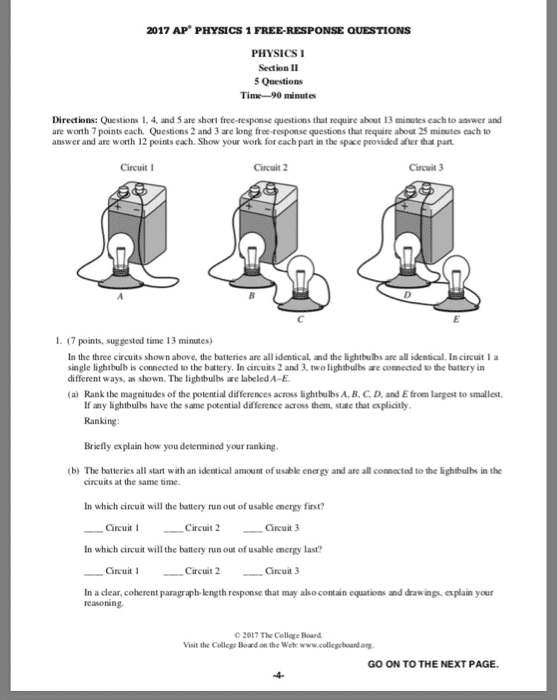
AP Physics 1 Free Response Questions
The AP physics 1 Free Response section includes several question types, such as Experimental Design (one question) and Short Answer/Paragraph Argument (two questions). Each of these types assesses a different learning objective. Some of the question types focus on specific skills, such as designing a scientific investigation, interpreting data from laboratory experiments, or integrating quantitative and qualitative reasoning. Short Answer/Paragraph Argument questions focus on specific learning objectives that are not covered by other question types.

AP physics 1 free-response section
The AP Physics 1 free-responses section has three types of questions. One question assesses student ability to design a scientific investigation. Another examines student understanding of quantitative and qualitative reasoning. Finally, the Short Answer section focuses on learning objectives that are not covered in the other sections of the exam. Here are some tips for aceing the free-response section.
AP Physics 1 is known to be difficult. In the year 2021, only 42% of students passed the exam, with only 7% achieving the top score of 5. This low passing rate is due in part to the free-response section, which many students struggle with. The good news is that there is a solution to this problem: study problems. More problem sets will help you master material and familiarize yourself with the format of the AP Physics 1 free-response section.
Calculator: The AP Physics 1 exam allows the use of a calculator, but it must be free from any features that are not approved by the College Board. The College Board provides a list of approved graphing calculators. Alternatively, you can look at the equation sheet to see the list of equations commonly used in physics. You can view it here. The AP Physics 1 free-response section is a good way to assess your performance in the subject.
Exam length
The AP Physics 1 exam contains a free response section of five questions, which accounts for 50% of your score. The five questions are comprised of three short answers, one experimental design question, and one qualitative and quantitative question. Students are required to write their own answers to these questions. Teachers grade the answers and determine whether or not they give partial credit. Here are some tips to help you answer the questions correctly.
There are two types of free response questions on the AP Physics 1 exam: an experimental design question and a qualitative/quantitative translation question. The experimental design question is worth 12 points and consists of pulling on rods until they break. Record the maximum force, Fmax, that is applied to the rods just before the rods break. Repeat the experiment several times to reduce error. It’s also important to repeat the experiment with different radii.
Number of questions
The AP Physics 1 free response section includes several different question types. One question assesses the student’s experimental design, analyzing laboratory data, and translation of qualitative reasoning. Another question focuses on the student’s ability to formulate a coherent argument. The final two questions are short answers that assess learning objectives not covered in other question types. Here are tips for completing the free response section of the exam.
AP Physics 1 free response questions account for approximately half of the total exam score. The other half is comprised of multiple choice questions. Students should spend enough time practicing the free response section to make it as efficient as possible. Thankfully, Albert has hundreds of multiple-choice questions that correspond with the course objectives. It is a great way to brush up on your exam-taking skills and ace the AP exam.
Techniques to maximize points
If you haven’t studied enough for the AP Physics 1 exam, you may be wondering how to maximize points on AP Physics 1 free-response questions. The exam has five free-response questions, and the time to complete them is 90 minutes. It is critical to be as efficient as possible. Here are five techniques to maximize points on the exam:
First, know the types of questions on the AP Physics 1 free-response section. There are three different types of questions: multiple-choice questions, paragraph-length answers, and short-answer questions. Some of these questions are single-select, while others require a student to answer multiple-choice questions in a paragraph. You should know that the College Board weights questions that use experimental design or qualitative/quantitative translation as twelve points. Short-answer questions, on the other hand, are seven-point questions.
The free-response section is normally completed in 45 minutes. If you’re halfway through, you’re doing great, but if you’re behind significantly, you should pick up the pace. Remember that you don’t have to answer every question in the order you received it. Try skimming through a few questions at the beginning of the section to reduce error and give yourself plenty of time for the harder questions.

Comments (0)